Dog Food
Can Dogs Eat Celery? The Benefits of Celery for Dogs!
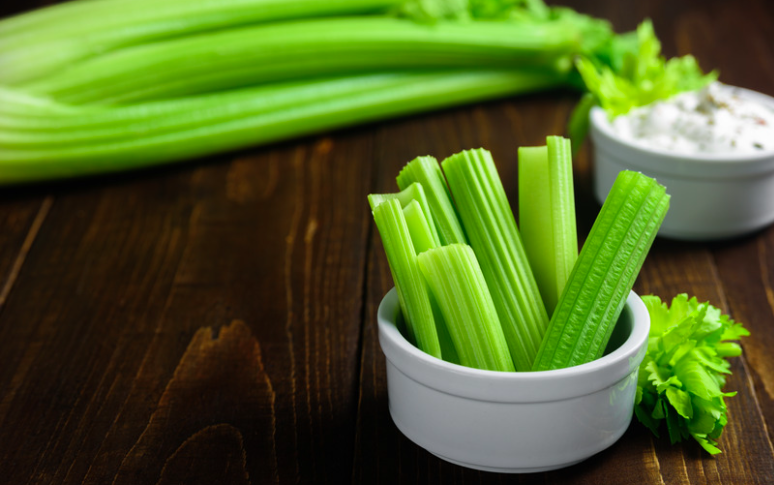
Can Dogs Eat Celery? Benefits of Celery for Dogs!
You’ve probably found yourself sitting at your dining room table with a piece of celery in your hand, contemplating whether or not your dog might benefit from a bite or two. A variety of fruits and vegetables, including celery, can be used to make delectable treats for both you and your dog. Continue to read to learn more about the advantages and disadvantages of feeding this vegetable.
Is Celery Safe for Dogs to Eat?
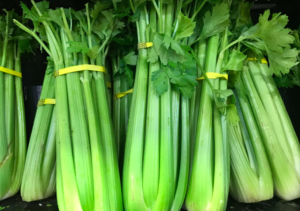
Yes, your dog will be able to consume celery. Celery is high in nutrients and could be a nutritious addition to your dog’s food as a nutritional supplement. Like any other food you would like to include in your diet, celery can be beneficial to dogs when consumed in moderation.
When determining how much celery your dog can safely consume, the size of your dog should always be taken into consideration. This canine-friendly vegetable can provide many essential nutrients, yet it should not be utilized as a complete meal substitute.
Many doctors advise dog owners to include celery in their dog’s diet as an occasional treat if their dog is overweight or at risk of becoming overweight. It receives a paw of approval for crunchiness, and because it is composed primarily of water, it may be satisfying for your dog to gnaw on a hot summer afternoon.
Nutritional Values for Celery
According to the USDA, the following is the nutritional information for 1 cup of raw, chopped celery (about 101 grams):
- 14 Calories
- 0.7 grams of protein
- 0.2 gram of fat
- 3 grams of carbohydrate
- 1.62 grams of dietary fibre
- Vitamin A of 453 IU
- 263 mg of Potassium
- Vitamin K (29.6 mcg)
- 40.4 mg of calcium
- Magnesium is 11.1 mg
The Advantages of Feeding Celery
When consumed in moderation, celery can provide some health benefits to your pet while also serving as an awesome treat. Here, understanding the advantages is critical, as is recognizing when feeding your pet this green vegetable becomes “too much.”
Celery includes a variety of critical nutrients, with vitamin A being the most notable of these. Providing your pet buddy with vitamin A helps to maintain healthy skin and a healthy coat, ensuring that they always look their best.
Besides fibre, celery contains several other essential nutrients that help to guarantee that your dog’s digestive tract is operating at optimal performance levels. Please remember that fibre can be difficult on your dog’s digestive tract if consumed in large quantities or regularly.
One way to know if your dog is consuming too much fibre is if they are experiencing more gas than usual after eating their meal. It is also possible that celery can be beneficial to dogs suffering from arthritis.
How? Because of its anti-inflammatory characteristics, celery is widely used as an anti-inflammatory agent, which can help reduce inflammation around your pup’s joints. This makes it much easier for your beloved pet to move around.
Despite its high nutritional value, it can be one of the most beneficial vegetables to include in your pup’s diet provided it is in moderation. Celery also contains significant amounts of thiamin, riboflavin, niacin, vitamin B5, vitamin C, and vitamin K, making it a nutritional powerhouse in the green-vegetable area.
Ensure, however, that you are giving celery in conjunction with a nutritious source of protein. Having learned that dogs may consume celery, here are some additional advantages of including this green vegetable in your dog’s diet:
- It has anti-inflammatory properties.
- Aids in the digestion of food
- It provides satisfaction to a hungry canine.
- 95 per cent of water could hydrate your pup
How You Can Prepare Celery for Dogs Using These Steps
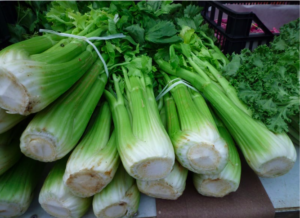
To prepare celery for your dog, start with a small amount and introduce it gradually, just as you would with any new food. When compared to prescribed dosages, the amount that your dog may be able to tolerate may differ.
In order for you to ensure that your dog gets the best possible celery experience, here are some helpful suggestions:
1). Eat it raw or prepare it differently.
It doesn’t matter how you serve it to your dog. If you intend to feed your dog celery, make sure that it is sliced into smaller bite-sized pieces before giving it to him. Keep in mind that if you cut them too small, they could become choking hazards (especially for smaller dogs).
Cooked celery may be preferable to raw celery for older dogs because it is simpler to chew and digest for them. Experiment with several serving methods to determine which method your dog prefers to consume their greens.
2). Opt for organic products.
If at all feasible, get organic produce. Using this method, you can keep pesticides off the vegetables you feed your pet (and yourself).
3). Always wash your vegetables before feeding them.
You wouldn’t want to eat contaminated vegetables, and your dog would feel the same way. If you do not get organic celery, make certain that the celery you intend to offer to your dog has been cleansed and that it is always fresh.
4). Don’t bother with the seasoning!
Dogs do not require any additional spice on the vegetables that they consume. Certain flavours can be toxic to your dog, so it’s better to avoid using them altogether while cooking.
5). Make it a special treat for your Dog.
How many of you recall the legendary “Ants on a Log” snack from childhood? If you’re feeling inventive, here’s a dog-friendly meal that your puppy will enjoy!
“Ants on a Log” Snack that is dog-friendly
Ingredients:
- Celery
- Peanut butter that is free of xylitol
- Dog goodies or treats.
First, wash it and remove any leaves from it to prepare the celery. After that, you’ll incorporate the xylitol-free peanut butter.
It is also important and crucial to ensuring that the peanut butter you use does not contain xylitol, which is hazardous to dogs if taken in large quantities.
Add your dog’s favorite treat to the peanut butter and place it in the refrigerator for a few hours before serving.
As soon as you’re ready to feed these to your dog, cut them into bite-sized pieces and sit back and watch as your furry companion appreciates your hard work!
Always remember to consult with your veterinarian.
Dogs can safely eat and enjoy celery if consumed in moderation, such as a nice treat every now and again. Just keep in mind that the high fibre level of celery might be rough on your pup’s digestive tract if they consume too much of it.
The most important thing to remember is to always speak with your veterinarian before adding new foods into your dog’s meal plan. Even when they are beneficial to you, it is possible that this is not always the case for your four-legged companion.
We appreciate you taking the time to read!
Finally, we hope you found this article interesting? And what do you think about ”Can Dogs Eat Celery? The Benefits of Celery for Dogs!?”
Please get in touch with us if you would like to contribute to this article or advertise.
And let us know if you notice something that isn’t quite right.
Dog Food
The Comprehensive Guide to Garlic: Is Ginger A Safe Treat For Your Dog?
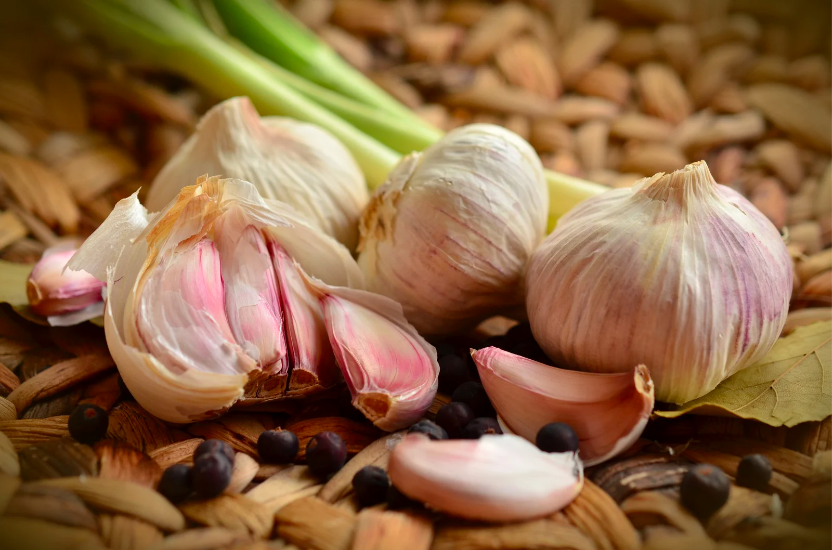
The Comprehensive Guide to Garlic: Is It Safe for Your Dog?
Garlic has long been a popular ingredient in kitchens worldwide. Known for its rich flavor and numerous health benefits, it’s a staple in many human diets. But what about our pets? Can garlic offer the same health benefits to dogs, or is it harmful?
In this extensive guide, we will explore everything dog owners need to know about garlic. From potential health risks to common myths and safe alternatives, this article will give you the facts, backed by science, to ensure your dog’s well-being.
What is Garlic? A Brief Overview
Garlic (Allium sativum) is a bulbous plant belonging to the Allium family, which also includes onions, leeks, and chives. It has been used in both culinary and medicinal practices for thousands of years, valued for its antibacterial, antifungal, and antioxidant properties. Garlic is known for its pungent aroma and bold taste, which enhances a variety of dishes.
While garlic provides humans with numerous health benefits, the question remains: is garlic safe for dogs? This is where the conversation becomes tricky, as garlic can be toxic to dogs in certain amounts.
Can Dogs Eat Garlic? Understanding the Debate
The primary issue with feeding garlic to dogs lies in the fact that it contains compounds known as thiosulfates. In dogs, thiosulfates can damage red blood cells, potentially leading to a condition called hemolytic anemia. While a small amount of garlic might not pose an immediate risk, larger amounts can cause serious health problems.
It’s essential to understand that garlic is not safe for dogs in significant quantities. Even though garlic is sometimes used in small doses in certain dog supplements, giving your dog garlic as a regular treat or as a supplement without consulting your veterinarian can be dangerous.
How Much Garlic is Toxic for Dogs?
The toxicity of garlic in dogs largely depends on the size of the dog and the amount consumed. According to veterinary experts, as little as 15-30 grams of garlic per kilogram of body weight can cause harmful effects. For smaller breeds, this could mean that even a small clove of garlic could be enough to cause serious symptoms.
The most common signs of garlic poisoning in dogs include:
- Vomiting
- Diarrhea
- Weakness or lethargy
- Rapid breathing
- Pale gums
- Elevated heart rate
If you suspect your dog has consumed a large amount of garlic, it is crucial to contact your vet immediately.
The Myth of Garlic as a Natural Flea Remedy
One of the most prevalent myths surrounding garlic is that it can be used as a natural remedy to repel fleas in dogs. While some dog owners swear by small doses of garlic to prevent fleas, scientific evidence supporting this claim is lacking. In fact, the potential risks far outweigh any unproven benefits. Flea prevention is best handled with products specifically designed for dogs, such as flea collars, topical treatments, and oral medications.
We do not recommend using garlic as a flea preventative. Always consult your vet for safe and effective flea treatments.
Why Garlic is Dangerous for Dogs: The Science Explained
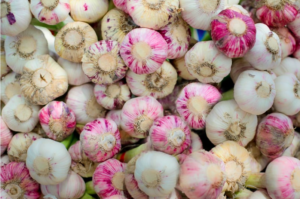
Garlic contains a compound called N-propyl disulfide, which can cause oxidative damage to a dog’s red blood cells. This damage can lead to hemolytic anemia, a serious condition that requires medical intervention. Even if garlic does not cause immediate symptoms, prolonged exposure over time can still harm your dog’s health.
In dogs, the consumption of garlic triggers the following harmful effects:
- Oxidative Stress: Garlic causes oxidative damage to red blood cells, leading to their premature destruction. This results in reduced oxygen-carrying capacity in the blood.
- Hemolytic Anemia: The destruction of red blood cells can cause hemolytic anemia, a life-threatening condition characterized by fatigue, weakness, and shortness of breath.
- Organ Damage: In severe cases, garlic toxicity can lead to organ failure, especially if the anemia is left untreated for too long.
Are All Forms of Garlic Harmful to Dogs?
It’s important to note that all forms of garlic are toxic to dogs—whether raw, cooked, powdered, or as part of a seasoning. Many people assume that cooked garlic might be less harmful than raw garlic, but the toxic compounds in garlic remain even after cooking.
Additionally, garlic powder, which is often found in human foods and seasonings, is particularly dangerous due to its concentrated form. Even small amounts of garlic powder can cause toxicity in dogs.
What Should I Do If My Dog Eats Garlic?
If your dog accidentally consumes garlic, it’s essential to act quickly. Depending on the amount ingested and the size of your dog, garlic can have immediate or delayed effects. Follow these steps if you believe your dog has eaten garlic:
- Assess the Situation: Determine how much garlic your dog consumed and the type (raw, cooked, or powdered).
- Watch for Symptoms: Monitor your dog for any signs of garlic poisoning, such as vomiting, diarrhea, weakness, or pale gums.
- Call Your Vet: Contact your vet immediately for advice. They may recommend bringing your dog in for an examination or inducing vomiting if the ingestion was recent.
- Follow Treatment Recommendations: Your vet may perform blood tests to check for hemolytic anemia and administer treatments like IV fluids, medications, or even a blood transfusion in severe cases.
Safe Alternatives to Garlic for Dogs
While garlic should be avoided, there are plenty of safe and healthy alternatives that can provide similar benefits without the risks. Here are a few dog-friendly alternatives to consider:
- Pumpkin: Rich in fiber and vitamins, pumpkin is a great addition to your dog’s diet for digestive health.
- Carrots: Low in calories and high in nutrients, carrots make an excellent snack for dogs.
- Blueberries: These antioxidant-packed berries can help support your dog’s immune system.
- Parsley: Known for its fresh scent, parsley can help freshen your dog’s breath without the dangers of garlic.
How to Prevent Accidental Garlic Consumption
Since garlic is a common ingredient in many human foods, it’s important to take steps to prevent your dog from accidentally consuming it. Follow these tips to keep your dog safe:
- Avoid feeding table scraps: Many human dishes contain garlic or garlic powder, so it’s best not to feed your dog leftovers.
- Check food labels: Always check the ingredients of any pre-packaged foods or treats you give your dog to ensure they are garlic-free.
- Store garlic out of reach: Keep garlic bulbs, powders, and other seasonings stored securely where your dog cannot access them.
Garlic Supplements for Dogs: Are They Safe?
Some dog supplements on the market contain garlic in small amounts, usually marketed for flea prevention or immune support. However, the safety of these supplements is still a topic of debate among veterinarians. We recommend avoiding garlic supplements unless specifically prescribed by your vet.
If you’re looking for immune-boosting supplements for your dog, there are many safe alternatives that do not include garlic, such as those containing omega-3 fatty acids, probiotics, or turmeric.
Conclusion: Is Garlic Safe for Dogs?
In conclusion, while garlic may offer several health benefits for humans, it’s not a safe food for dogs. Even small amounts of garlic can cause serious health issues, including hemolytic anemia, oxidative stress, and organ damage. If you want to provide your dog with nutritious treats, there are many safer alternatives available.
When it comes to your pet’s health, always consult your veterinarian before introducing any new food or supplement into their diet. By being mindful of what your dog consumes, you can ensure they stay healthy and happy.
Frequently Asked Questions (FAQs)
How much garlic is toxic to dogs?
Garlic can be toxic to dogs in relatively small amounts. Ingesting 15-30 grams of garlic per kilogram of body weight can cause harmful effects, including hemolytic anemia. For small dogs, even one clove of garlic can pose a serious risk.
Can garlic be used in small amounts for flea prevention?
Despite some claims, there is no scientific evidence that garlic is an effective flea preventative for dogs. Additionally, the potential toxicity of garlic outweighs any unproven benefits for flea control.
Is cooked garlic less toxic than raw garlic?
No, cooking does not reduce the toxicity of garlic for dogs. Whether raw, cooked, or powdered, garlic remains harmful to your pet and should be avoided.
What should I do if my dog eats garlic by accident?
If your dog consumes garlic, contact your veterinarian immediately. Symptoms of garlic poisoning can take time to appear, and your vet can provide guidance based on the amount consumed and your dog’s size.
What are some garlic-free foods I can safely give my dog?
Some safe and nutritious alternatives to garlic include carrots, pumpkin, blueberries, and parsley. These foods provide health benefits without the risk of toxicity.
We appreciate you for taking the time to read this article!
Finally, we hope you found this article interesting? And what do you think about ”The Comprehensive Guide to Garlic: Is It Safe for Your Dog?!?”
Please feel free to share or inform your friends about this article and this site, thanks!
And let us know if you observe something that isn’t quite right.
Dog Food
A Complete Guide to Feeding Your Pregnant Dog for Healthy Puppies

Optimal Nutrition for Expecting Dogs: A Complete Guide to Feeding Your Pregnant Dog for Healthy Puppies
Are you ready to ensure the health and vitality of your beloved pregnant pup and her future litter? Just like us, our canine companions require optimal nutrition during pregnancy to nurture healthy puppies. In our comprehensive guide, we dive into the essential components of feeding your expecting dog, from week-by-week dietary adjustments to crucial supplementation advice.
Throughout the stages of pregnancy, it’s vital to understand the unique nutritional needs of your pregnant bitch. From maintaining her ideal weight in the early weeks to transitioning to puppy food as the litter grows, each phase requires tailored feeding strategies. We also delve into the importance of vital vitamins and minerals, water intake, and the risks of over-supplementation to ensure a smooth pregnancy and post-birth period.
Embark on this journey with us as we navigate the intricate world of feeding pregnant dogs for optimal health and wellness. Whether you’re a seasoned breeder or a first-time dog parent, this guide is your go-to resource for supporting your pregnant bitch and welcoming thriving puppies into the world.
Understanding the Nutritional Needs of a Pregnant Dog
When your beloved furry friend is expecting, it’s crucial to ensure that she receives proper nutrition throughout her pregnancy. A pregnant dog has unique nutritional requirements that differ from those of a non-pregnant female dog.
As the puppies develop, the pregnant bitch experiences increased nutritional demands of gestation. Her body works hard to support the growth of the little ones inside her, and it’s up to you to provide her with the right food intake to meet those needs.
Imagine your pregnant dog as a new mum-to-be, nurturing her babies with the nutrients from her own body. Just like human mothers, she needs a well-balanced diet rich in essential nutrients to support her own health and the development of her puppies.
Proper nutrition plays an important role in maintaining the overall health of the female dog during this special time. It helps to strengthen her immune system, ensuring that she can fight off any potential illnesses and provide the best possible start for her puppies.
Failing to meet the nutritional requirements of a pregnant bitch can lead to serious consequences, such as malnourishment of the bitch and poor fetal development. This is why it’s essential to work closely with your veterinarian to create a tailored feeding plan that meets your pregnant pet’s needs.
💡 Key Takeaways: Proper nutrition is crucial for pregnant dogs to support their increased nutritional demands, maintain overall health, and ensure healthy fetal development.
The First Half of Pregnancy: Weeks 1-6
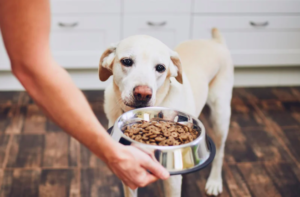
During the first few weeks of gestation, your pregnant dog’s nutritional needs remain similar to those of a non-pregnant dog. The focus should be on maintaining her ideal weight to ensure a healthy pregnancy.
Imagine your dog as a mother-to-be, carefully nurturing the tiny lives growing inside her. In these early weeks, she doesn’t need extra calories, but rather a consistent, high-quality diet to provide the necessary nutrients for her developing puppies.
Feeding your pregnant bitch a well-balanced, nutrient-rich food during this time will help her maintain her energy levels and support the initial stages of fetal development. Stick to her regular adult-formula food, and monitor her weight to ensure she’s not gaining or losing too much.
💡 Key Takeaways: In the first 6 weeks of pregnancy, maintain your dog’s ideal weight with a balanced diet to support early fetal development.
Adjusting Diet in the Later Stages: Weeks 6-9
As your pregnant dog enters the later stages of her pregnancy, her energy and nutrient needs will increase to support the rapid growth of her puppies. This is when adjusting the feeding regimen becomes crucial.
Imagine your dog’s belly growing rounder each day, as her puppies develop and demand more nutrition. During this time, her food intake should increase by 15-25% to accommodate the extra energy required for fetal growth.
The amount of adjustment needed will depend on factors such as the litter size and your dog’s individual energy requirements. Smaller breeds may need a higher percentage increase compared to larger breeds.
One way to meet these increased nutritional demands is by transitioning to a high-quality puppy formula food. Puppy food is specially formulated to provide the extra nutrients and calories needed for growing puppies, making it an excellent choice for pregnant mothers too.
When making the switch, do so gradually over a week to avoid digestive upset. Mix increasing amounts of the puppy food with her current food until she’s fully transitioned.
💡 Key Takeaways: In the later stages of pregnancy, adjust your dog’s feeding regimen to meet her increased energy and nutrient needs, considering factors like litter size and breed-specific requirements.
The Importance of Puppy Food During Pregnancy
Transitioning your pregnant dog to a high-quality puppy formula food is an important step in ensuring she receives the necessary nutrients for healthy fetal development. Puppy food is designed to have higher nutrient density compared to adult dog food, making it an ideal choice for pregnant bitches.
Imagine your growing puppies as tiny sponges, absorbing all the nutrients from their mother to support their rapid development. Puppy formula food provides the concentrated nutrition they need to thrive.
Look for a puppy food that is rich in essential nutrients like protein, calcium, and folic acid. These nutrients play critical roles in the development of strong bones, healthy organs, and proper neural tube formation in the puppies.
Feeding your pregnant dog a premium puppy formula throughout her pregnancy will give her the extra boost of nutrients she needs to support the growth of her litter.
💡 Key Takeaways: Transitioning to a nutrient-dense puppy formula food during pregnancy provides the essential nutrients needed for healthy fetal development.
Essential Vitamins and Minerals for a Healthy Pregnancy
While a well-balanced puppy formula food should provide most of the necessary nutrients, some pregnant dogs may benefit from additional vitamin and mineral supplements. However, it’s crucial to consult with your veterinarian before starting any supplementation.
One important nutrient for pregnant dogs is folic acid, which helps prevent birth defects and supports healthy fetal development. Many prenatal vitamins designed for pregnant dogs contain folic acid along with other essential nutrients like calcium and iron.
Calcium is another critical mineral for pregnant dogs, as it supports the development of strong bones and teeth in the puppies. However, it’s important to ensure that your dog receives an adequate intake of calcium rather than over-supplementing, which can lead to health issues.
💡 Key Takeaways: Consult with your veterinarian to determine if your pregnant dog needs additional vitamin and mineral supplements, such as folic acid and calcium, to support healthy fetal development.
Feeding Schedule and Portion Sizes: A Tailored Approach
When it comes to feeding frequency and portion sizes for your pregnant dog, a tailored approach based on her individual needs is best. As her energy requirements increase, you may need to adjust her feeding schedule and portion sizes accordingly.
Imagine your pregnant dog as a mom-to-be with a growing appetite, needing more frequent meals to support her energy levels and the growth of her puppies. Depending on her breed and size, you may need to increase her daily feedings from two to three or even four meals per day.
Monitoring your dog’s body condition throughout her pregnancy is key to ensuring she receives adequate energy intake without becoming overweight. Adjust her portion sizes based on her weight gain and energy levels, and consult with your veterinarian if you have any concerns.
💡 Key Takeaways: Tailor your pregnant dog’s feeding schedule and portion sizes based on her individual needs, considering factors like breed, size, and body condition.
The Role of Water in Pregnancy and Lactation
Adequate water intake is essential for your pregnant dog’s health, as it supports her increased blood volume and helps maintain proper hydration. Encourage your dog to drink plenty of fresh, clean water throughout her pregnancy.
As your dog’s body prepares for lactation and milk production, her water requirements will continue to increase. Ensure that she always has access to fresh water, especially if she’s consuming a dry food diet.
💡 Key Takeaways: Provide your pregnant dog with ample fresh water to support her hydration needs and prepare her body for lactation and milk production.
The Dangers of Over-Supplementation
While it may be tempting to give your pregnant dog extra supplements to ensure she’s getting all the necessary nutrients, over-supplementation can be dangerous. This is particularly true for calcium, as excessive calcium intake can lead to serious health issues.
If your pregnant bitch is already consuming a well-balanced, high-quality puppy formula food, she likely doesn’t need additional supplements. Always consult with your veterinarian before starting any supplementation to ensure your dog receives an adequate intake of calcium and other essential nutrients without overdoing it.
💡 Key Takeaways: Avoid over-supplementing your pregnant dog, especially with calcium, as it can lead to health issues.
Managing Morning Sickness in Pregnant Dogs
Just like human moms-to-be, some pregnant dogs may experience morning sickness, particularly in the early stages of pregnancy. If your dog shows signs of nausea or vomiting, it’s essential to provide her with the right nutritional support.
Offer your dog small, frequent meals throughout the day to help manage her nausea. You may also consider feeding her a bland diet, such as boiled chicken and rice, to help settle her stomach. If her morning sickness persists or becomes severe, consult with your veterinarian for guidance.
💡 Key Takeaways: Manage morning sickness in pregnant dogs with small, frequent meals and a bland diet if needed.
Preparing for Lactation: Nutrient Intake Post-Birth
As your pregnant dog gives birth and begins lactating, her nutritional needs will continue to be high. Milk production requires a significant amount of energy and nutrients, so it’s crucial to support your new mum with a diet that meets her increased demands.
Imagine your dog nursing her newborn puppies, providing them with the nourishment they need to grow and thrive. To produce enough high-quality milk, she’ll need a diet rich in protein, calcium, and other essential nutrients.
Continue feeding your lactating dog a premium puppy formula food, as it contains the necessary nutrient density to support milk production. You may need to increase her food intake by up to 50% compared to her pre-pregnancy diet to ensure she has enough energy to produce milk and maintain her own body condition.
Offer your nursing dog frequent meals throughout the day, as she may feel more comfortable eating smaller portions more often. Ensure that she always has access to fresh water, as lactation can increase her fluid requirements.
💡 Key Takeaways: Support your lactating dog’s increased nutrient needs with a high-quality puppy formula food and frequent meals to ensure adequate milk production and maintain her body condition.
Evaluating and Adjusting the Diet Post-Weaning
As your dog’s puppies begin to wean and transition to solid food, it’s important to re-evaluate your dog’s nutritional needs. Her energy requirements will decrease as the puppies become less dependent on her milk, so you’ll need to adjust her feeding regimen accordingly.
Imagine your dog’s puppies growing more independent, exploring their new world and relying less on their mother’s milk. As this happens, gradually decrease your dog’s food intake to prevent unwanted weight gain.
Monitor your dog’s body condition closely during the weaning process, and adjust her portion sizes as needed to maintain a healthy weight. Slowly transition her back to her pre-pregnancy adult dog food, ensuring that it still provides a balanced and complete nutrition.
💡 Key Takeaways: Adjust your dog’s feeding regimen post-weaning to prevent unwanted weight gain and ensure a balanced diet as her energy requirements decrease.
Importance of Monitoring Body Condition and Nutrition
Throughout your dog’s pregnancy and lactation, monitoring her body condition and nutritional status is essential. Regular check-ups with your veterinarian can help ensure that your dog maintains a healthy weight and receives the necessary nutrients for optimal health.
Your veterinarian can assess your dog’s body condition score, which is a measure of her fat and muscle mass. They can also recommend any necessary adjustments to her diet or supplementation based on her individual needs.
💡 Key Takeaways: Regular monitoring of your dog’s body condition and nutritional status is crucial for maintaining her health during pregnancy and lactation.
Common Concerns and Solutions for Feeding Pregnant Dogs
Feeding pregnant dogs can come with its own set of challenges, but with the right knowledge and resources, you can navigate these concerns successfully. One common issue is malnourishment of a bitch, which can occur if she’s not receiving enough nutrients from her diet.
To prevent malnourishment, ensure that your pregnant dog is consuming a high-quality, nutrient-dense food that meets her increased energy and nutrient needs. Avoid feeding her a poor-quality diet or one that doesn’t provide the necessary balance of nutrients.
Another concern is morning sickness, which can make it difficult for your dog to keep her food down. If your dog experiences persistent vomiting or loss of appetite, consult with your veterinarian to rule out any underlying health issues and develop a plan to manage her symptoms.
💡 Key Takeaways: Address common concerns like malnourishment and morning sickness by providing a high-quality diet and seeking veterinary guidance when needed.
Supplemental Feeding: When to Consider and What to Avoid
In some cases, your pregnant dog may benefit from supplemental feeding to ensure she’s receiving all the necessary nutrients. This is particularly true if she’s a picky eater or has a low body condition score.
One option for supplemental feeding is bitch pills, which are specially formulated prenatal vitamins for pregnant dogs. These supplements can help provide essential nutrients like folic acid, calcium, and iron to support healthy fetal development.
However, it’s important to choose a high-quality supplement and to follow the dosage instructions carefully. Avoid giving your dog human prenatal vitamins, as they can contain ingredients that are harmful to dogs.
If you’re considering supplemental feeding, always consult with your veterinarian first. They can help you determine if supplementation is necessary and recommend the best products for your dog’s individual needs.
💡 Key Takeaways: Consider supplemental feeding, such as bitch pills, for pregnant dogs who may not be receiving all the necessary nutrients from their diet, but always consult with a veterinarian first.
Conclusion
In conclusion, ensuring optimal nutrition for your expecting dog is crucial for the health and well-being of both the mother and her future puppies. By understanding the nutritional needs of a pregnant dog and making the necessary dietary adjustments throughout the different stages of pregnancy, you can support the growth and development of healthy pups.
Transitioning to puppy food, providing essential vitamins and minerals, monitoring body condition, and avoiding over-supplementation are key factors in promoting a successful pregnancy and lactation period.
Remember, proper hydration, monitoring for signs of morning sickness, and addressing malnourishment concerns are all essential in caring for your pregnant bitch. By following a tailored feeding schedule, incorporating the right nutrients, and being attentive to your dog’s needs, you can nurture a thriving litter and set the foundation for their overall health. Thank you for embarking on this journey with us towards raising happy and healthy puppies with optimal nutrition.
We appreciate you for taking the time to read this article!
Finally, we hope you found this article interesting? And what do you think about ”A Complete Guide to Feeding Your Pregnant Dog for Healthy Puppies!?”
Please feel free to share or inform your friends about this article and this site, thanks!
And let us know if you observe something that isn’t quite right.
Dog Food
Unleashing the Champion Within: Sports Nutrition and Diet Plans for Peak Performance
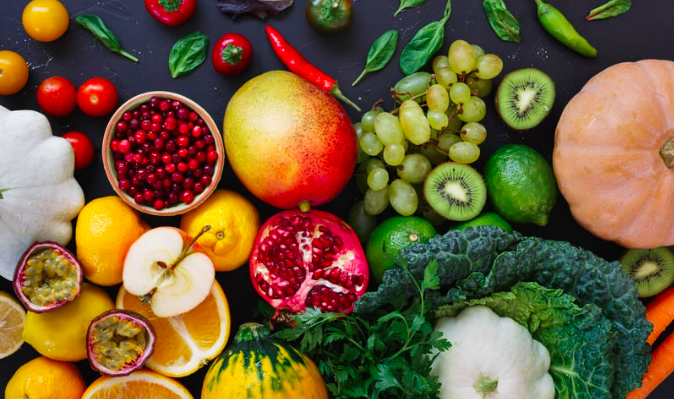
Unleashing the Champion Within: Sports Nutrition and Diet Plans for Peak Performance
For every wagging tail crossing the finish line or every frisbee soaring through the air in a dazzling catch, there’s a dedicated athlete behind it – and a meticulously crafted diet fueling their success. In the competitive world of canine sports, nutrition isn’t just about kibble and cuddles; it’s a strategic weapon for optimizing performance, recovery, and overall well-being.
Whether your furry friend is a champion agility competitor, a tireless dock diving daredevil, or a canine marathon machine, their dietary needs are far from ordinary. This comprehensive guide delves into the fascinating world of Sports Nutrition and Diet Plans for dogs, empowering you to become your pup’s personal nutritionist and unlock their athletic potential.
Understanding the Canine Athlete’s Nutritional Needs
Just like human athletes, canine competitors have unique energy demands. Unlike their leisure-loving counterparts, sporting dogs require a diet specifically designed to meet their heightened activity levels. Here’s a breakdown of the key factors to consider:
- Energy Expenditure: Sports can significantly increase a dog’s calorie burn. A high-performance diet should provide enough calories to fuel intense workouts and aid in recovery.
- Macronutrients: The building blocks of energy, macronutrients like protein, carbohydrates, and fats play crucial roles in muscle building, recovery, and sustained performance.
- Micronutrients: Don’t underestimate the power of vitamins, minerals, and antioxidants. These micronutrients support various bodily functions and overall health, crucial for optimal athletic performance.
By understanding these core principles, we can create personalized Sports Nutrition and Diet Plans tailored to your dog’s specific needs.
Fueling Champions: Macronutrients for Peak Performance
The three macronutrients – protein, carbohydrates, and fats – form the foundation of a canine athlete’s diet. Each plays a vital role in energy production, muscle repair, and overall health.
Protein: The building blocks of muscle tissue, protein is essential for growth, repair, and recovery after strenuous exercise. Active dogs generally require a higher protein intake compared to their less active counterparts. Aim for diets containing 25-40% protein from high-quality sources like chicken, fish, eggs, or lean meats.
Carbohydrates: The primary source of readily available energy, carbohydrates provide the fuel your dog needs to power through workouts and competitions. Complex carbohydrates like whole grains and vegetables offer sustained energy release, while simple carbohydrates like fruits can be beneficial for quick pre-exercise boosts.
Fats: Often demonized, healthy fats are an essential part of a canine athlete’s diet. They provide a concentrated source of energy, aid in vitamin absorption, and support healthy skin and coat. Look for diets rich in omega-3 and omega-6 fatty acids from sources like fish oil, flaxseed, or chicken fat.
Tailored for Success: Developing a Sports Nutrition Plan
Now comes the exciting part – crafting the perfect Sports Nutrition and Diet Plan for your furry athlete! Here’s a step-by-step guide:
- Consider Your Dog’s Breed, Age, and Activity Level: Different breeds have varying metabolic rates and exercise needs. A young, high-energy Border Collie will require a different diet plan compared to a senior Greyhound.
- Consult Your Veterinarian: Discuss your dog’s specific needs and activity level with your vet. They can help you assess your dog’s overall health and recommend a suitable dietary approach.
- Choose a High-Quality Dog Food: Look for commercially available dog foods specifically formulated for active dogs. These diets typically have higher protein and fat content to meet the demands of an athletic lifestyle.
- Portion Control is Key: Even the best diet can be rendered ineffective by overfeeding. Measure your dog’s food carefully and adjust portions based on their activity level and weight.
- Pre- and Post-Workout Nutrition: Similar to human athletes, dogs can benefit from pre- and post-workout meals. A small, easily digestible meal before exercise provides readily available energy, while a protein-rich meal after helps with muscle recovery.
- Hydration is Essential: Just like us, dogs sweat during exercise and need to stay hydrated. Ensure fresh, clean water is readily available throughout the day, especially during and after workouts.
Beyond the Bowl: Optimizing Performance with Supplements
While a balanced diet is the foundation, certain supplements can further enhance your dog’s athletic performance and recovery. Here are some to consider, but always discuss them with your veterinarian first:
- Glucosamine and Chondroitin: These support joint health, crucial for active dogs.
- Fish Oil: Rich in omega-3 fatty acids, fish oil can aid in reducing inflammation and promoting muscle recovery.
- Probiotics: Promote a healthy gut microbiome, essential for optimal nutrient absorption and digestion.
- Electrolytes: Electrolyte-replacement solutions can be helpful for dogs engaged in prolonged activities, especially in hot weather, to replenish lost minerals through sweat.
Remember, supplements are not a magic bullet. A balanced diet should always be the primary source of your dog’s nutrients.
Specialized Diets for Specific Sports
Different canine sports have varying demands. Here’s a glimpse into specialized diets for specific athletic pursuits:
- Endurance Athletes: Dogs like marathon runners or sledding champions require diets high in fat (30-40%) for sustained energy. Look for diets rich in omega-3 fatty acids for optimal cardiovascular health.
- Power Athletes: Think weight pullers or sprinters. These dogs benefit from diets with moderate protein (30-35%) and high carbohydrates (40-50%) for quick bursts of energy.
- Working Dogs: Police K-9s, agility competitors, and herding dogs need diets with balanced protein (25-35%) and carbohydrates (40-50%) to provide sustained energy for various activities throughout the day.
Traveling Champions: Nutrition on the Road
Dog shows, agility competitions, and flyball tournaments often involve travel. Here are some tips to ensure your furry athlete stays fueled for success on the road:
- Stick to the Familiar: A sudden change in diet can upset your dog’s stomach, especially during stressful travel. Pack enough of their usual food for the entire trip.
- Portion Control on the Go: Traveling can disrupt your dog’s routine. Adjust meal portions to account for decreased activity levels during travel days.
- Portable Hydration: Invest in a travel water bottle and collapsible bowl to ensure your dog stays hydrated throughout the journey.
- Travel Treats Wisely: Skip sugary treats and opt for healthy, protein-rich snacks like freeze-dried meat or dehydrated vegetables.
Kitchen Chemistry: Crafting Homemade Diets for Active Dogs
While commercially available dog foods are convenient, some pet parents prefer crafting homemade meals for their canine companions. If you choose this route, remember:
- Consult a Veterinary Nutritionist: Developing a balanced homemade diet requires expertise. A veterinary nutritionist can guide you on formulating a meal plan that meets your dog’s specific needs.
- Prioritize Quality Ingredients: Use fresh, human-grade ingredients like lean meats, whole grains, and vegetables. Avoid processed foods, artificial additives, and unhealthy fats.
- Portion Control is Crucial: Just like with commercial food, portion control is essential to avoid overfeeding, even with homemade diets.
Senior Salute: Nutritional Considerations for Aging Athletes
As our furry friends age, their nutritional needs evolve. Here’s how to adjust your dog’s diet plan to support their athletic spirit in their golden years:
- Reduced Calorie Intake: Senior dogs have lower energy requirements. Reduce calorie intake to prevent weight gain and manage joint health.
- Focus on Digestibility: Senior dogs might have trouble digesting certain foods. Choose highly digestible protein sources and incorporate prebiotics for gut health.
- Joint Support Supplements: Glucosamine, chondroitin, and fish oil can be beneficial for maintaining joint health in aging athletes.
- Hydration is Key: Dehydration becomes a bigger concern with age. Ensure your senior dog has constant access to fresh water.
Conclusion: Fueling Champions for Life
By implementing a strategic Sports Nutrition and Diet Plan, you can empower your canine athlete to reach their full potential and thrive on the playing field (or pool, or track!). Remember, a healthy diet is just one piece of the puzzle.
Regular exercise, proper training, and quality veterinary care are all essential for a successful and fulfilling athletic journey for your dog. With dedication and the right nutrition plan, your furry friend can become the ultimate champion, both in competition and in your heart.
Frequently Asked Questions (FAQs)
Can I give my active dog human food as part of their diet?
While occasional healthy human snacks like fruits or vegetables are okay, a dog’s nutritional needs are different from humans. Stick to a balanced dog food formulated for active dogs and consult your veterinarian before introducing any human food into your dog’s diet.
What are some signs my dog might not be getting the right nutrients?
Lethargy, excessive weight loss or gain, dull coat, and digestive issues can all be signs of an inadequate diet. If you notice any of these signs, consult your veterinarian to discuss your dog’s nutritional needs.
How often should I feed my active dog?
The frequency of feeding depends on your dog’s age, activity level, and the specific diet you choose. Generally, active dogs benefit from smaller, more frequent meals (2-3 times a day) compared to the traditional once-a-day feeding schedule. This helps them maintain consistent energy levels throughout the day. Consult your veterinarian or the feeding recommendations on your chosen dog food for specific guidance.
Is it safe to give my dog protein supplements?
While protein is crucial for an active dog, excessive protein intake can be harmful. Consult your veterinarian before giving your dog any protein supplements. They can assess your dog’s individual needs and recommend the appropriate protein intake based on their age, breed, and activity level.
What are some healthy homemade treat options for active dogs?
Skip the sugary store-bought treats and opt for homemade alternatives packed with protein and healthy fats. Here are some ideas:
- Baked sweet potato slices: Rich in complex carbohydrates and potassium, these provide sustained energy.
- Frozen banana chunks: A refreshing and potassium-rich treat perfect for hot days.
- Dehydrated meat jerky: Made with lean meats like chicken or turkey, this is a protein-packed and long-lasting treat option.
- Frozen yogurt with berries: A healthy and satisfying treat, just be sure to choose plain yogurt with no added sugar and use dog-safe berries like blueberries or raspberries.
Remember, moderation is key even with homemade treats. Consult your veterinarian for portion recommendations based on your dog’s individual needs.
By providing a balanced diet, tailored to your active dog’s specific requirements, you can fuel their athletic spirit and keep them performing at their peak!
We appreciate you for taking the time to read this article!
Finally, we hope you found this article interesting? And what do you think about ”Unleashing the Champion Within: Sports Nutrition and Diet Plans for Peak Performance!?”
Please feel free to share or inform your friends about this article and this site, thanks!
And let us know if you observe something that isn’t quite right.
-

 Pet Care2 years ago
Pet Care2 years agoThe Best Dog Collars For 2022
-

 Dogs2 years ago
Dogs2 years agoBichon Frise: The Happy, Playful, and Cuddly Companion
-

 Trending Pet Stories1 year ago
Trending Pet Stories1 year ago2023 ‘World’s Ugliest Dog’ Winner: Scooter’s Tale of Resilience
-

 Animals3 years ago
Animals3 years agoAre There Animals Having Down Syndrome?
-

 Pets2 years ago
Pets2 years agoThe Fascinating World Of The Red Chameleon
-

 Dogs3 years ago
Dogs3 years agoTop 10 Most Popular Dog Breeds According To AKC.
-
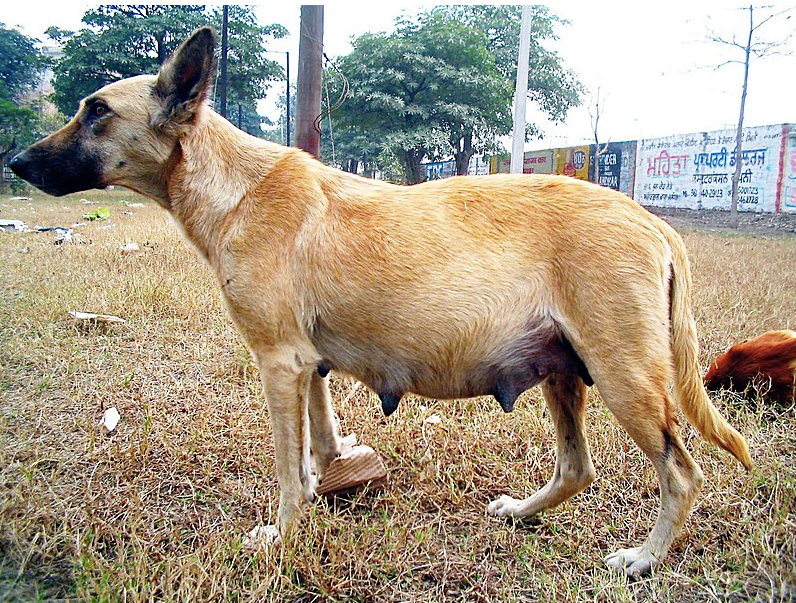
 Dogs2 years ago
Dogs2 years agoDogs 5 Weeks Pregnant: A Comprehensive Guide To Canine Pregnancy
-

 Dogs3 years ago
Dogs3 years ago21 Dog Breeds That Resemble Bears Or Teddy Bears!







